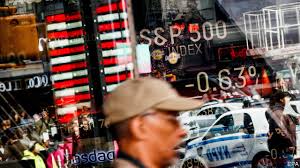Watchdogs are worrying about a booming corporate-credit market

INVENTORS OF FINANCIAL terminology have little love for language. “Leveraged loans” are at first sight a tautology: in fact they are loans, usually arranged by banks among a syndicate of lenders, to highly indebted companies. “Collateralised loan obligations” (CLOS) are another mouthful. These are not abstract nouns but legal entities, run by asset managers, private-equity firms, hedge funds or others, that own more than half of American leveraged loans. CLO managers chop the loans into slices and sell the parts to match their investors’ appetites for risk.
However ugly its terms, both borrowers and investors have discovered beauty in the market for leveraged loans. Some financial watchdogs, with memories of the crisis of 2007-08 still fresh, fear that the loans will soon lose their looks. In recent days Janet Yellen, who headed the Federal Reserve until January, and Daniel Tarullo, the Fed’s chief bank supervisor after the crisis, have joined the chorus of concern.
Leveraged loans have been booming. In America, where the bulk are raised, the stock comfortably exceeds $ 1.1trn, twice as much as six years ago (see chart). It is “unlikely but not impossible” that issuance there this year will pass 2017’s record of $ 650bn, says Ruth Yang of S&P Global, a rating agency. (Estimates vary: some, including Dealogic, a data provider, reckon that the market is bigger still.)
According to S&P, more than a third of recent American leveraged loans have refinanced existing debt. A thinner slice goes on private-equity firms’ dividends. A good deal of the rest pays for mergers and buy-outs—most eye-catchingly this year the purchases by Blackstone, a big private-equity house, of part of Thomson Reuters, a financial-data company, and by Carlyle Group, another buy-out firm, of the speciality division of AkzoNobel, a Dutch chemicals firm.
Lenders find leveraged loans attractive for several reasons. They have offered good returns when interest rates have been ultra-low; this year, according to J.P. Morgan, they are among a handful of assets earning American investors more than three-month cash. Because most are at floating rates, they pay more as rates rise; corporate bonds, by contrast, tend to have fixed rates. And they usually come with collateral, putting leveraged-loan investors ahead of unsecured creditors should a borrower default. Borrowers like the loans because initial interest rates tend to be lower than on bonds, they are easier to repay early and they involve less administrative bother.
A decade of easy credit has given borrowers the upper hand. That shows not only in low rates but also in the decline of covenants—eg, requiring borrowers to keep a certain capacity to absorb losses to protect lenders in the event of default. Before the crisis, most leveraged loans had some such covenants. Now most are “cov-lite”. Christina Padgett of Moody’s, another rating agency, thinks that the amount of relatively senior, cov-lite loans in companies’ capital structures has grown so much that lenders can expect to recover less in the next downturn than hitherto if borrowers default. She forecasts that recovery rates, 77% on average since 1988, will decline to 61% or so.
Declining standards have watchdogs worried. An American court’s ruling in February, which relieved CLOs of a regulatory obligation to retain some of the risk of the loans they slice and sell, has done nothing to soothe them. In April the International Monetary Fund detected traits “reminiscent of past episodes of investor excesses”. In September the Bank for International Settlements noted that defaults had picked up and that rising American interest rates could trigger more. Downgrades of stressed borrowers could force “fire sales” of illiquid loans. Ms Yellen worried to the Financial Times about “systemic risk”; Mr Tarullo fretted to Bloomberg that it was unclear “who owns this debt”.
When such folk hear echoes of 2007-08, it would be foolish not to pay heed. Eventually the cycle will turn and investors will suffer. But the outlook is still largely benign. Interest rates, though rising in America, are still low—and rock-bottom in the euro area. A leveraged-finance banker says that investors in leveraged loans carry out careful “primary diligence” of corporate borrowers before lending them money. Before the crisis buyers of toxic mortgage-backed securities, each housing thousands of loans, undertook no such close scrutiny.
Recent jitters in the American stockmarket may suggest that investors are less keen on risk. Ms Padgett says that the leveraged-loan market has so far shrugged those jitters off. But she adds: “If the markets remain rocky, that will have an impact on leveraged finance. At least, it has historically.” Whether or not it is time to worry, this is a market to watch.
This article appeared in the Finance and economics section of the print edition under the headline “Load bearing”
